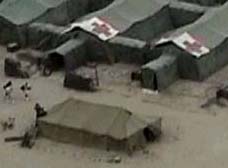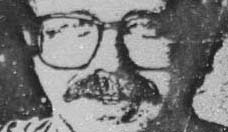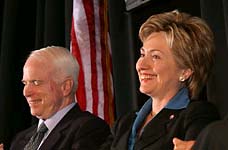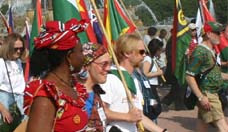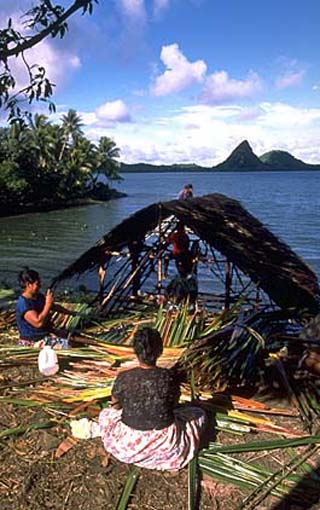
In launching a large Micronesia program, the Peace Corps had advertised, only half ironically, that it was going to paradise. The result was an ambitious, overextended, and controversial program involving hundreds of volunteers. We joked that if the same ratio of volunteers to locals prevailed in, say, India, there would be no young people left in the United States.
Micronesia RPCV P. F. Kluge writes: When I left the island of Saipan after two years of Peace Corps service in the late 1960's, I promised myself that I would return as often as possible
Saipan: From Then to Now
Jan 1, 2006 - Contemporary Pacific
When I left the island of Saipan after two years of Peace Corps service in the late 1960$, I promised myself that I would return as often as possible. That's not the same as living there, certainly not the same as having been born there. But it's a promise that I have kept and still keep. I was back in the early 19705 to work for the Congress of Micronesia's Future Political Status Commission, in the mid-iyjos to work for the Micronesian Constitutional Convention. Magazine assignments brought me back, as did the research for my 1991 book The Edge of Paradise: America in Micronesia. Most recently, I was invited back to give a speech in connection with the sixtieth anniversary of the World War II; battle for Saipan.
What follows is an edited version of "Saipan: From Then to Now," delivered to an audience of veterans and Saipan residents on 16 June 2004.
I'll begin with a scrap, just a scrap, of poetry. If you travel around Australia and drop in for an early evening drink at a Returned Servicemen's Club, you'll find that, at precisely 7 PM, the lights will flicker, the place will fall silent, the drinking will stop, and someone will read this 1914 poem by Laurence Binyon, a poem in memory of young men who died.
They shall not grow old, as we that are left grow old:
Age shall not weary them, nor the years condemn.
At the going down of the sun and in the morning
We will remember them . . .
(Laurence Binyon, "For the Fallen")
Now, this is a time of remembering on Saipan. I have reflected about what I might say to you or whether I had any right to stand before you at all. I was not a part of the battle, and whatever my times on Saipan over the years have amounted to, they were never a matter of life and death. So what business does a former Peace Corps Volunteer have at a battle memorial? And what can someone from a small college in Ohio have to say about Saipan, where he doesn't live, doesn't own property, doesn't vote?
The answer is that I keep thinking about Saipan, wherever I am, and keep returning; and each return-this one, no exception-is more surprising than the last. Saipan is an island that is defined by its ability to reinvent itself, to startle, intimidate, charm, and appall. It's a place that canover and over again-win your heart, and break it, and take it back.
I wonder what it looks like-make that, feels like-to those of you who saw this place in 1944. It must be as if you have traveled through two dimensions: not just space-many long miles-but time as well, sixty years of it. Half a world, more than half a century: that's quite a trip. It speaks well of you that you have come, and of the Northern Marianas government that it has welcomed you. There will always be a place for you here, I suspect. I remember a line of William Faulkner's: "The past isn't over," he said. "It isn't even past."
This afternoon, I'll attempt to connect the then-the battleground Saipan of history books and newsreels-with the now, the rich and bewildering island you encounter today. Let me start with this: As we mark the sixtieth anniversary of the battle of Saipan, it must be pointed out that World War II was not fought to liberate Saipan. The fate of this island-a legal League of Nations mandate under Japanese administration, an island well on the way to being absorbed within the Japanese imperium-was on no one's list of primary, secondary, or incidental war goals. In war, as in real estate, location is everything, and Saipan's location on the route to Japan is what mattered.
Still, it is equally true that, whether by accident or design, the battle of Saipan was the beginning of an otherwise improbable engagement between a post-World War II superpower-never more powerful than then-and a small Pacific island.
From the start it was a complicated relationship, involving affection and force, bona fide goodwill and cold-eyed calculation- from both sides. It was not entirely military, not even in the early years, and is not entirely civilian, not even now. After the war, the people in the US State Department, not to mention those at the United Nations, stipulated that the captured Micronesian islands should be developed, economically and politically. Our UN trusteeship specified that self-government or independence (or both) would eventually be offered. What's more, it was understood that the trusteeship would be kept intact, as a whole: no changing borders, no division, no side deals.
But the people at the defense department had their own requirements: understandably they wanted access to the islands they had captured at such cost. They had plans for parts of Micronesia: the Marshalls, Palau, the Northern Marianas-especially Saipan and Tinian. And they insisted on the right of denial for all of Micronesia: no other nation could establish a competing presence here, military or commercial. Furthermore, though all the islands were a UN trusteeship, this particular trusteeship was a strategic one, not at the mercy of hurlyburly free-swinging orators in the UN General Assembly. Instead, Micronesia was subject to the controlling veto of the United States in the UN security Council.
What it all comes to is that tensions existed in the US approach to Micronesia from the beginning, contradictions and cross- purposes, especially between the departments of state and defense, and especially concerning Saipan. The US Naval Administration ended in 1952, and the US Department of Interior took over the Trust Territory. But soon the Northern Marianas were given back to the military, mainly because a secret guerilla-training operation was based on Saipan. The Naval Technical Training Unit (NTTU), it was called, an educational institution whose graduates-Nationalist Chinese and possibly Indonesian-have no alumni association and no class reunions.
The locals called it "the secret place." They talked of late night flights coming into Kagman Field, of passengers shunted onto buses with blacked-out windows. Years later, I heard of people who lived on Saipan in the sixties meeting other people who acknowledged that they, too, had spent time on Saipan. When? they would be asked. In the fifties, they would reply, and a curtain would come down on the conversation. A vow of secrecy. Who couldn't be curious about the Naval Technical Training Unit? I checked aerial photographs, looking for NTTU installations. The most promising areas were whited-out.
I hiked the boondocks they once used: a foundation with a rusted-out Coke machine was all I found. Even with a huge cash advance from a publisher, subpoena powers, a battery of lawyers, and many syringes of sodium pentothal, a writer might not capture the Naval Technical Training Unit-a great story that, almost certainly, will never be told. Not until this shadowy outfit decamped was Saipan placed under Trust Territory-that is, US Department of Interior-control. That was in the early sixties. A few years later I arrived; I am glad that my time to discover Saipan was then, not later, not now. I'm not sure I could hack it now or would want to try, or that I would fall for the place as I did back then.
In launching a large Micronesia program, the Peace Corps had advertised, only half ironically, that it was going to paradise. The result was an ambitious, overextended, and controversial program involving hundreds of volunteers. We joked that if the same ratio of volunteers to locals prevailed in, say, India, there would be no young people left in the United States.
The Saipan we came to was no paradise, that was clear. Almost a quarter century had passed since the shooting had stopped, and yet the place was still shaped, defined, by the battle that had been fought here. Long after the combat stopped, long after the naval administration walked away from its camps and Quonsets and airfields, the island was . . . well . . . haunted. It was like a theater that had been abandoned by actors and by audience, a place still littered with costumes and props, ticket stubs and programs in the aisles. Have you ever, driving around America, gone past an old outdoor drive-in theater, the big screen still standing, weeds in the parking lot, long semicircular rows of those little parking- meter-like poles evenly spaced, and the ruins of a rickety, graffiti- marked projection booth in the middle of it all? That was what Saipan felt like.
It had a kind of sullen magic. Scarred, handsome, and in its way, beautiful. It invited exploring. It made you think. And it was all about the past; it was about some of you who gather here now. It was about you, this sighting out from the invasion beach at landing craft and tanks impaled on the reef. It was about you, when I went swimming off the rusting breakwaters and half-sunken barges at Charley Dock. It was about you, traveling in and off the islands, waiting at little Kobler Field for a 00-3. You were there, your spirit lingered at Isley Field, with overgrown bunkers and revetments, all the giant footsteps of another time.
Saipan then was one of those rare, dear places where you could confront history without a ticket, a tape-recorded spiel, a forced march through a museum, and a sign warning you about all the things you weren't supposed to do. In the villages-Garapan, Susupe, Chalan Kanoa-it was about you, in the remnants and ruins of destroyed Japanese buildings, bullet-pocked walls and cisterns, overgrown gardens; about you as well in the scrap metal and lumber taken from the empt\ied internment camps, hammered into houses, and collected and rehammered after typhoons, when people came back from bunkers and old Japanese buildings where they had taken shelter during the storms.
You were on the roads, in surplus jeeps the Saipanese had purchased at $1 each. You were in the roads themselves, those roads that, more than anything else, made Saipan special: it was the only Trust Territory island west of Majuro where you could spend more than a minute in third gear. And what places there were to go to! There was Capitol Hill, up on Mount Tagpochau; the locals called it Mount Olympus. You couldn't see it from out at sea, couldn't see it from down below at sea level, and you couldn't see it if you were a member of a UN visiting mission.
By 1967 the former NTTU headquarters had become the seat of the Trust Territory government, with the high commissioner in the highest house, and other worthies, including a handful of Micronesians, down below, all of them in a little America of airy, spacious typhoon-proof houses surrounded by grassy, well-barbered lawns, with a view far, far out to sea; in the mornings, you could see clear to Anatahan Island, if you knew just where to look. Sure, I was a Peace Corps Volunteer, I lived way down below, in a funky house with holes in the roof and floor, but could I be blamed if, then and for years to come, I defined success in life-having it made- as a house on Capitol Hill? That, too, was a legacy of the war.
The past was all around: the Sugar King Monument, the jail where Amelia Earhart was said to have languished and died. Off the road- sometimes, just off the road-were tanks, bunkers, and debris you'd drive past every day, never suspecting they were there, until a typhoon peeled back the brush and exposed the marks of war. But no place so rewarded exploring as the Marpi District at the north end, toward Suicide and Banzai cliffs. Most of the place was off limits then: this was where the ammunition for the planned invasion of Japan had been stored. After Colonel Paul Tibbets intervened, the ordnance was a headache.
Shipping it off island was expensive and pointless; dumping it into the sea was laborious and dangerous. What to do? Someone evidently suggested destroying the stuff by detonating it in place. It half worked: the shells were scattered, higgledy-piggledy, all over the place-in the open, buried in the ground, half in, half out-and often still intact. This led to a local industry, a kind of reckless handicraft: people slipping into Marpi to strip valuable copper and bronze fittings off the still- lethal ammunition. The clinking of hammers against metal sounded through the boondock nights, sometimes punctuated by the blast of an exploding shell.
By the time I arrived, a wry and memorable fellow named Steve Aiken led a crew, disarming and collecting the bombs. I used a version of him in my first novel; later he attempted a novel himself. Aiken picked his way through flatlands, past the so-called Last Command Post, the caves that had been blasted shut in battle, that now, with time, were slowly opening, revealing sake bottles, mess kits, helmets, bones. It could make a person thoughtful. My guide to the cliffs -from which enemy soldiers and civilians jumped to the death in what may have been the worst mass suicide in history- was Tony Benavente, a policeman when I met him, who had been present when the American invaders tried to coax frightened people into surrendering.
I remember the way he pointed at the cliffs, the height, the jump, the dying fall. And I remember wondering aloud which would have been worse, going off Suicide Cliff onto hard ground hundreds of feet below, or going off Banzai Cliff into turbulent, beautifully blue, shark-infested waves. I remember Tony Benavente's shrug.
The battles we remember this week were resonant and pervasive. It wasn't just a matter of marks on the land; it was reflected also in island life, not only in roads and jeeps and houses, not just in the remnants and -to put it directly-remains of a great battle, it was right there on island tables, in the enduring love of Spam, in the leftover knives, forks, and plates you saw at island parties, with navy insignia and initials. It was in the songs that sounded out of jukeboxes in ramshackle bars along Beach Road. The bars were never busier than on those tumultuous, loose-lipped Payday Fridays, every other week, when government employees invested their pay in endless Budweisers.
In the background, the music was American, country western, plangent, plaintive left-behind tunes like "Please Release Me, Let Me Go"-which summarizes the Saipanese attitude towards the trusteeship and thus qualifies as an informal anthem of today's commonwealth. Or "Am I So Easy to Forget?" and-I kid you not-"You Are My Sunshine." And there were certain phrases you could hear that reflected military history. A new hire was always "coming on board." And if you returned here after years away, some old friend would ask, "Where are you stationed now?" It was more than I could manage to reply that, well, I wasn't really "stationed" anywhere.
But the largest legacy of the battle of Saipan was in the Saipanese regard for the United States. On other Micronesian islands, the war had swept quickly by, as at Kwajalein and Enewetok, or been confined to specific secondary islands, like Peleliu and Angaur in Palau. Other places-Truk, Yap, Ponape, Kusaie -had been spared land fighting. Here in the Northern Marianas the battle had been followed by camps, roads, bases, new construction, secret training operations. The military left a larger, longer mark. No wonder that, when I arrived in 1967, it was easy to see that the Saipanese weren't happy with being part of, indeed the capital, of the Trust Territory of Pacific Islands, the scattered and improbable "TT."
In many ways, the TT was mission impossible. As editor of a magazine called the Micronesian Reporter and author/editor of an island guidebook, I learned to rattle off the following sentences from memory: "The Trust Territory has 2,141 islands with an aggregate landmass half the size of Rhode Island scattered over an area the size of the continental United States, and a population of 120,000 that could be-possibly should be-accommodated in the Pasadena Rose Bowl. It has six districts, nine mutually unintelligible languages, and a subsistence economy of fishing and farming, as well as the copra trade, scrap metal, and government employment ..." About then, people's eyes started glazing over, like yours.
If I persisted, it would be to add that this was the last post-World War II UN Trusteeship, and that America, which (perish the thought) was not a colonial power, was supposed to offer the people a choice about their future government and political status- eventually, sort of, somehow, maybe...
The Saipanese disliked the Trust Territory and in a moment I will tell you why. Before that, I want to do something that I never thought I'd do. Way too late for it to make a difference to anyone but me, I would like to say a few good words about the TT government. They got a lot of bad press from a lot of people, myself included. The "rust Territory" it was called: second-rate, war- surplus equipment, second-rate war-surplus officials, time servers, political hacks, career-paper pushers, friends of wellplaced friends, all hunkering down or hiding out in a comfy cul-de-sac. What we had here was a holding operation, low in budget, low in vision, energy, purpose.
And there was something to this criticism. There were some remarkable people-I was tempted to say cases-out here, people who just weren't up to much. And, caught as it was between cross-purposes, keeping the islands secure for the military while somehow advancing self-determination, between developing the place and yet preserving it, the Trust Territory had not accomplished a great deal. Should they keep alive the world of thatched roofs, traditional navigation, subsistence fishing and agriculture? Or import California, the sooner the better? The Japanese had been busy in Micronesia, busy with plantations- sugarcane especially, coffee, even rice.
There was fishing, there was mining. There was colonization: streets, trains, buildings, temples, gardens. Settlers and settlements. Though the Trust Territory made progress in health care, education, local government, they hadn't revived the private sector-and the memory, the very ruins of Japanese enterprise, were a source of constant reproach, reflected in the bitter, much-quoted epithet that the Spanish came for god, the Germans came for gold, the Japanese came for glory, and the Americans came for good.
Still, looking back on that admittedly torpid time, I remember people who loved this place, who worked quietly and cared. Whatever they attempted-their wins and losses-they were determined that no harm should be done. That's not a recipe for robust growth, granted, but I would pause before condemning what can come off as a condescending, go-slow, the-islands-are-fragile, the-people-aren't- ready attitude. People thought it was patronizing. Maybe so. It was, after all, a trusteeship. But when I return here, I find myself asking whether the pell-mell exploitation, the get-rich deals that occurred in a few years of self-government don't far outweigh what happened during the long yawning decades of trusteeship.
And though the Trust Territory reposes in history's dustbin, it must be granted that there was an idealism underlying the notion of a nation of federated, disparate states. Pathetic as it was, the Trust Territory, if it had worked-a huge if-might have had something to teach Kashmir, Iraq, the former Yugoslavia, the Sudan. But, as it happened, other lessons were coming.
The Saipanese, for years, petitioned for separation. They petitioned visiting UN missions, they petitioned at the UN, they passed resolution after resolution, they inv\ited other nations, numerous other nations, to put in a bid, make a play, anything but this captivity, this long sleepwalk. Whether in reunion with Guam or on their own, the Northern Marianas wanted out of Micronesia and into a close permanent relationship with the United States. And- here's where the past impinges-the reason or part of the reason for this was the lesson in US power and largesse first demonstrated on the invasion beach, in the battle we remember now.
Everything follows from that, every intended or unintended result, every consequence and every accident.
Well, there is something to be said for knowing what you want and working for it steadfastly, through years of rejection. Sooner or later you win, and you only need to win once. In the late sixties, the Trust Territory's Congress of Micronesia began serious negotiations with the United States about the future. The other five districts wanted a loose relationship with the United States. They knew they needed aid and protection, but they insisted on sovereignty, on control of their lands, on the option -later on-to change or end their arrangement with the United States. Simply put, they wanted the advantages of dependence and the benefits of independence.
Free association, they called it. So they rejected the idea of annexation to Hawai'i and thus to the United States, they rejected the chance to become a US territory, and another offer, to become a Commonwealth. This was too much for Saipan to bear, and in Palau, in April 1972-I was in the room-the other Micronesians at last acceded to the Marianas' request for separate talks with the United States, an offer the United States instantly accepted. With that, the chance of the Trust Territory producing a united Micronesia died; this not-quite colony, this accidental state, with its six-star flag and a national anthem based on a melody of Brahms, perished.
And the US Commonwealth that welcomes you today was born. I wonder what you make of it. I wonder what I make of it. I was here, in 1975, when 78.8 percent of Northern Marianas voters decided to become US citizens and to make their islands a permanent part of the United States. It was an emotional moment and the emotions, in my case, were mixed. It was touching, it was a tribute, to see Saipan and the other Northern Marianas freely elect to join the United States, to see years of determination at last rewarded. It wasn't what the war was about, nor was it the aim of the naval administration of the islands.
It wasn't what the US Departments of Interior and State had planned and, for sure, it wasn't what the United Nations had envisioned. But doesn't that make it all the more impressive? Think of it, coming back here, greeting old friends as fellow countrymen, fellow citizens. How can I, you-anybody -fail to approve? And, speaking of happy endings, shouldn't it be pointed out that America's three predecessors-Spain, Germany, Japan-never dreamed of offering or honoring the kind of choice the Marianas made?
But . . . well, there's always a but . . . my emotions were mixed. And are. Put aside as so much youthful fantasy the idea of a united Micronesia coming out of the Trust Territory. Enough of that. Put aside anybody's pleasure in seeing friends get what they want: better houses, higher land values, cars, traffic lights, duty-free shops, a Washington office. Put aside that the Northern Marianas' escape from the other Micronesian states had its pragmatic side, the escape of the rich, or potentially rich, from the relatively-in some cases, irretrievably-poor. Let's be frank: There were two measures of island wealth at that time.
One was real or imagined military value to the United States. In short: location, location, location. This, the Northern Marianas had. The other was imminent potential for tourism: access for warm-weathering visitors from Japan. The Northern Marianas had that as well. So what we saw was a separation of the haves rom the have-nots. And, lest anyone suggest that the Northern Marianas were particularly uncharitable to less well- endowed neighbors, let's note that the division of erstwhile Trust Territory along economic-and racial -lines continued. The Marshalls and Palau-both with military assets-peeled off from Truk, Ponape, Yap, and the new state of Kosrae.
Everybody was taking their best shot, making their best deal. And the people of the Northern Marianas joined the long list of those who came to the United States for reasons of opportunity, economic opportunity. Nothing new about that, nothing wrong. These seekers after a better life surely outnumber the persecuted pilgrims, hounded idealists, political refugees. They include my parents and, possibly, yours.
And that is the end of all my putting aside and the beginning of my perplexity. Anyone who was on an island that was converted, overnight, into American soil, its people, overnight, into American citizens, had to wonder. Those parents of mine traveled from Europe- Germany-to the United States. They renounced one nationality, one loyalty, for another. They took a voyage, made a pledge, learned a new language. They came to America. But America came to Saipan: citizenship was conferred, on terms that Saipan's Washington lawyers and Washington's Washington lawyers worked out. I couldn't help wondering what America, and American citizenship, would mean under these circumstances: American citizenship, home-delivered.
Was it about shared values? Or shared value? I'm still wondering, still watching. It's what keeps me coming back. What does it mean to become American, in this way, at this date, at this distance?
Now, in an island vastly transformed since becoming part of America, there remains cause for celebration and concern. What I love, maybe more now than before, is the wild-card vitality, the buzz and hurly-burly, the characters who land-in some cases, wash up- here, searchers, dreamers, tax-dodgers, flimflam men, the hits just keep coming. What characters, what schemes, especially in the early years: an x-rated Doonesbury cartoon. This was let's-make-a-deal time, the coming of disco, duty-free karaoke, poker machines, etc, etc. A time in which opportunity shaded into opportunism. The world discovered Saipan; Saipan discovered the world.
Things got complicated and still are. The Saipan tourist industry is at the mercy of ups and downs in Japan, the wanderlust of mainland Chinese, the health of airlines, the outbreak of SARS [Severe Acute Respiratory Syndrome], the risk of terrorism. The garment industry thrives in the shadow of regulations, soon to go into effect, that will permit Chinese garments made in China into the US market. Will Chinese need to come to Saipan to sew? In its moment of greatest strength, Saipan is singularly vulnerable to outside forces beyond its control. All this is another way of saying it has ceased in an important way to be an island at all.
Forget your images of island life: Robinson Crusoe, Treasure Island, Shakespeare's Tempest, Fantasy Island, Napoleon on St. Helena. Forget the familiar island adjectives: remote, isolated, lonely, insular, self-sufficient. They don't apply. Saipan's not an island anymore. It's all connected.
The island's main export may be irony. I saw the first Japanese tourists in the late sixties: decorous, dark-suited, camera-toting groups, middleaged and older. I attended the opening of the first hotel, the Royal Taga. First and last, I thought. Was I wrong! Who could have guessed that a World War II battleground would turn into a Japanese Florida? Or that its transformation would mimic the 1944 campaign, first taking the invasion beaches, then heading north toward Marpi, duty-free shopping, souvenir and convenience stores and gaming emporia shooting galleries following along behind? And, among these nearly 500,000 visitors per year, there are fewer and fewer who come for the reasons that unite us today.
They walk past pillboxes and monuments on their way to the beach. Was there a battle here? Well, that was then and this is now. A famous victory? Never mind: sunburn lotion is their armor. Against this tide of indifference and forgetting, the memories we share and renew may amount to more than history. They may offer guidance in times ahead.
Talk about garment industries, talk about hotels and realize that they have one thing in common: a reliance on outside capital and outside labor. The Saipanese are agents, middlemen-not bosses, and rarely employees. Where are the Saipanese? The most enthusiastic celebrants of the US Commonwealth-and there is much to celebrate: hospitals, businesses, a likeable junior college-turn quiet when I inquire. The Saipanese are out-numbered, nearly two-to-one, on their own island, that's for sure, out-numbered by those waves of foreign workers, garment makers, security guards, barbers and beauticians, hostesses and maids, farmers and hardhats who have come to do the island's heavy lifting.
There were around 11,000 people in the Northern Marianas in 1967, mostly local, and now there are 75,000, mostly alien. Be careful what you wish for. Saipanese are a minority on their own islands-an elite minority, to be sure, and determined to stay that way, but a minority nonetheless. What, then, are they up to? What is their work, job, occupation, trade, calling? Their purpose or their passion? This is something that they may still be discovering. It's taking time. For the moment, most island citizens who work are employed by local and commonwealth government. That is cause for wonder. It will take a few trips to know whether the situation I've described can last: an entrenched government contending with outside money, transient workers.
I will not predict the worst: the island has a way of dodging bullets, pulling through. It has some magic. But if I predicted happy endings, we'd have to define terms. That's another trip.
I'll say this: there will be more battles on S\aipan-not like the one you fought, but battles nonetheless, with the character and direction of the island at stake. For now: tragedy and accident, coincidence and fortune have played a part in this island and its history: people acting selflessly, selfishly, the same people sometimes, motives mixed and tangled. This is the history that connects then and now. And, as ever, location. The northward flight of bomb-carrying 6-295 back then, the southward flight of tourist- packed 7475, today and tomorrow.
Thank you for coming and remembering. In a forgetting time, attention spans shortening, reaction times lengthening, it's the most important thing, morally imperative. People need to remember as they grow old; so do islands; so do nations. Siegfried Sassoon says this in his 1919 poem "Aftermath." Though it's set among the trenches of World War I, not the beaches of World War II, I believe it applies here and serves me well as an ending:
Have you forgotten yet? . . .
Look down, and swear by the slain of the War that you'll never forget.
...
Do you remember that hour of din before the attack
And the anger, the blind compassion that seized and shook you then
As you peered at the doomed and haggard faces of your men?
Do you remember the stretcher-cases lurching back
With dying eyes and lolling heads-those ashen-grey
Masks of the lads who once were keen and kind and gay?
Have you forgotten yet? . . .
Look up, and swear by the green of the spring that you'll never forget.
(Siegfried Sassoon, "Aftermath")
Thank you.
P F KLUGE, who served in the US Peace Corps in Micronesia, has worked as a reporter at the Wall Street Journal and as an editor at Life magazine and has written for numerous other publications. A contributing editor at National Geographic Traveler, Kluge is writer- in-residence at Kenyon, where he specializes in the reading and writing of American literature. He is perhaps best known in Pacific studies for his 1991 book The Edge of Paradise: America in Micronesia; his most recent novel is Final Exam, published in 2.005 by xoxox Press of Gambier, Ohio.
Copyright University of Hawaii Press 2006







